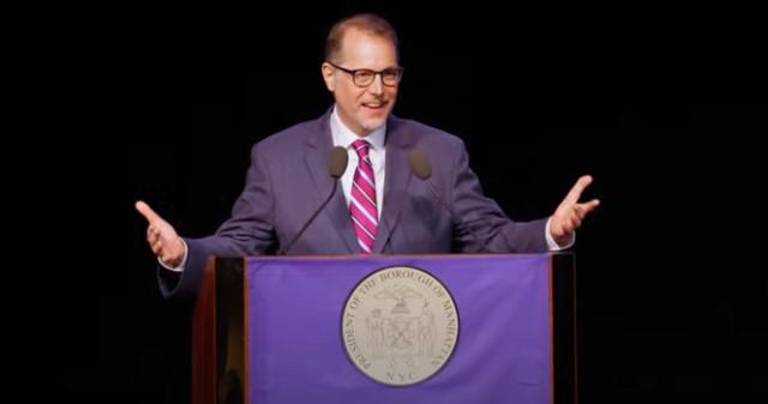Deepening Housing Crisis Emerges Amid Luxury Resurgence in Manhattan
The luxury condo market in Manhattan is booming and real state sources say private developers are eager to invest at the high end. But there were only 8,000 permits issued for new residential housing citywide in 2023. Borough president Mark Levine said long term, the lack of affordable housing is the “biggest crisis” facing Manhattan.


As luxury condos and rental units in Manhattan experience a resurgence following the pandemic, a growing inequality in securing fair housing is becoming evident for many New Yorkers.
Manhattan borough president Mark Levine in his state of the borough address delivered March 3 at Hunter College flagged housing as the borough’s “biggest crisis.”
“Skyrocketing rents are forcing out the very people who make Manhattan run–the teachers, nurses, artists, and even our kids. We’re losing the next generation of Manhattanites because they can’t afford to live here when they grow up. This can’t continue.”
Levine said he “scoured every block of this borough and identified dozens of sites where as many as 70,000 new housing units could be built. We used that data to release our ”Housing Manhattanites” plan to get the thousands of affordable units our city needs online, but we can’t do this alone.” He called on Albany to do more.
The first month of the year witnessed a significant uptick in luxury condo sales, with more than 200 contracts signed in New York City, marking a 30 percent increase from December 2023 and an 87 percent surge in dollar volume, partly fueled by declining mortgage rates, as reported by The Real Deal.
This resurgence in high-end real estate transactions, including a notable $149 million contract at Extell Development’s Central Park Tower, underscores the robust demand at the market’s upper echelons.
Out of the 200 contracts signed in January, 113 are for luxury condos in Manhattan.
On the flip side, New York City is currently experiencing its most severe housing shortage in more than 50 years, with vacancy rates among rentals plummeting to 1.4 percent, marking the lowest level since 1968.
The vacancy rate was 4.5 percent in 2021, and the city views a rate that is under 5 percent a “housing emergency.”
Eric Bottcher, representing the 3rd district of the New York City Council, which encompasses Greenwich Village, Chelsea, and Hell’s Kitchen, emphasized the critical need to construct over 800,000 units in the next decade, including housing for middle-income individuals. He highlighted that without such action, the stability of rent for the neglected middle class of New Yorkers would remain uncertain.
Bottcher recently teamed with Brooklyn borough president Antonio Reynoso to form a coalition of political leaders they dubbed the Housing League which is pushing pro development policies across the city. He said he is deeply committed to restoring the expired 421-a Tax Incentive, which provides a partial tax exemption for developers of new multiple dwellings aimed at the middle class.
“One reason why that kind of housing is not getting built is because the current tax structure makes it prohibitively expensive to build rental housing at a reasonable price. We need a replacement for the 421-a program that will facilitate the construction of rental units with an affordable comportment. When the supply of housing is increased, rent will stabilize,” Bottcher said.
“The 421-a program was utilized by the majority of new rental buildings in the 20 years before it was allowed to expire. If this program is not renewed, if a new version of this program is not introduced in this session, there will certainly be another year where there is no new housing in New York, and that will lead to consequences for rent across the board,” Bottcher said.
Data from FRED indicates a significant decrease in the number of new home permits issued by local authorities for privately-owned housing units in New York since May 2015, which marked its peak at approximately 15,500 permits. By comparison, the latest available data shows a stark decline, with only about 1,450 permits issued in December 2023.
“I believe all of last year, there were only 8,000 new housing units approved in New York. The population of New York City will continue to grow; there will be increased competition for the same amount of units available. You don’t need to be an economist to know what is going to happen to rent,” Bottcher said.
In the luxury market, the price per square foot increased year-over-year to the third-highest on record at $101.67. Median rent for doorman buildings rose to $5,002 compared to $4,665 in January of the previous year.
The market is expected to remain drum tight for the foreseeable future. “Inventory for both rentals and sales is tight,” said Roberto Cabrera a licensed associate real estate broker at Brown Harris Stevens Residential Sales, “If you don’t act sooner rather than later, it could very well become more expensive and more difficult to compete in the future,” said Cabrera, who also runs a newsletter regarding luxury buyers and renters.
January is often the start of new beginnings, so it is not uncommon to see lease signings in Manhattan surge year over year. However, this trend has been consistent for the third straight month, with 3,922 new leases of all units signed compared to 3,441 in January 2023, according to Mansion Global.
Meanwhile, a coalition of progressive housing activists, labor unions, and New York state elected officials is advocating for establishing a state social housing development authority.
As reported by the Commercial Observer, the proposed affordable housing coalition includes a left-leaning grassroots named Housing Justice for All, two sponsorships from state Sen. Cordell Cleare and Assemblymember Emily Gallagher, the Building & Construction Trades Council of Greater New York, representing more than 100,000 tradesmen and tradeswomen across New York City.
The coalition is pressing the state government for $5 billion in financing to initiate and build the inaugural phase of housing projects. Additionally, they seek an initial allocation of $71 million to establish the Social Housing Development Authority (SHDA).
This proposed authority would issue tax-exempt bonds to fund projects independently and may leverage a suggested state-funded voucher program to assist low-income tenants, CO reported.
Cabrera agrees with landlords and developers that rent control and rent stabilization laws hurt development long term. “Instead of stopping them from making money, focus on the good outcomes their efforts can bring,” he said.
Borough president Levine also emphasized the need for more incentives in his state of the borough where he outlined “a comprehensive housing agenda for Albany, calling for programs to convert vacant Midtown office buildings into housing, a new tax incentive plan to build more rental apartments, lifting outdated caps on building size, and ensuring landlords can only evict tenants for good cause.”